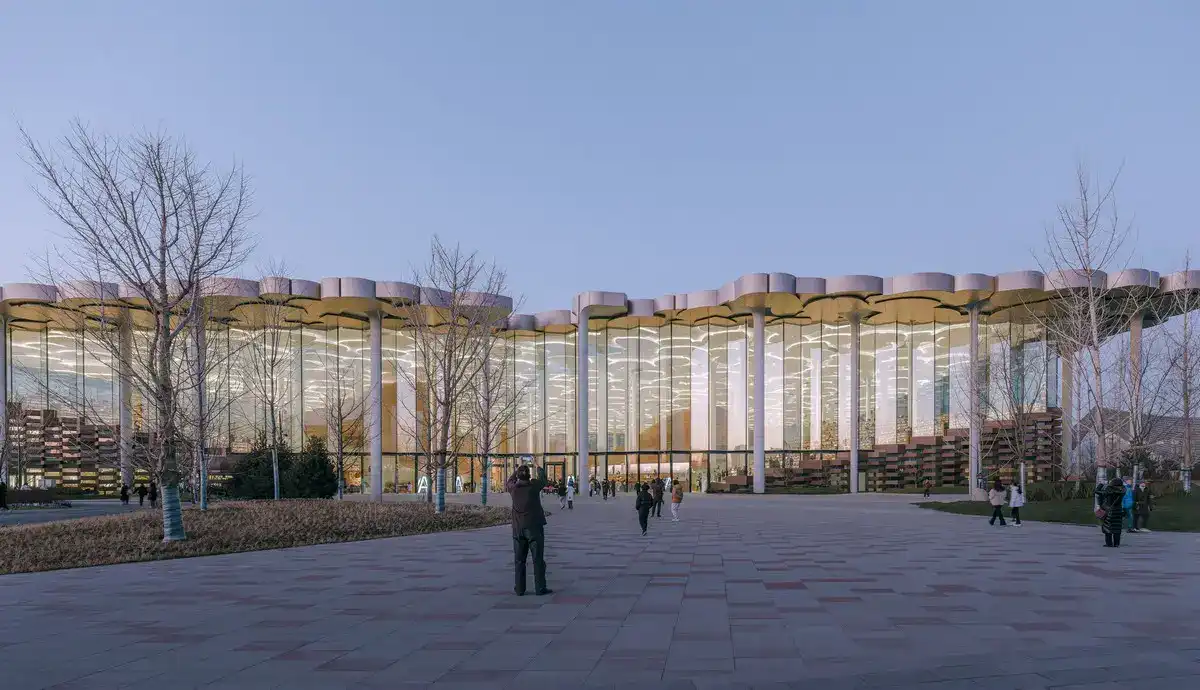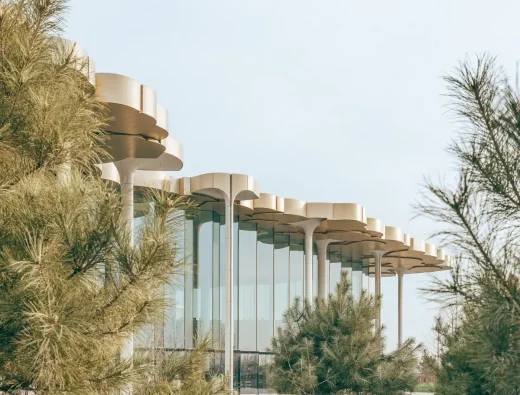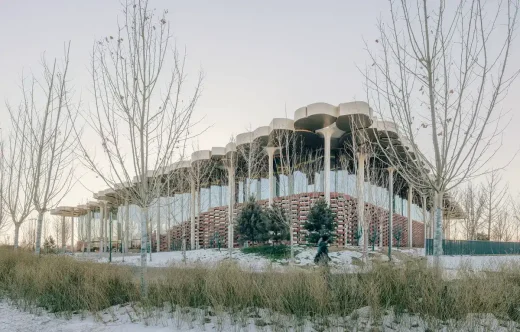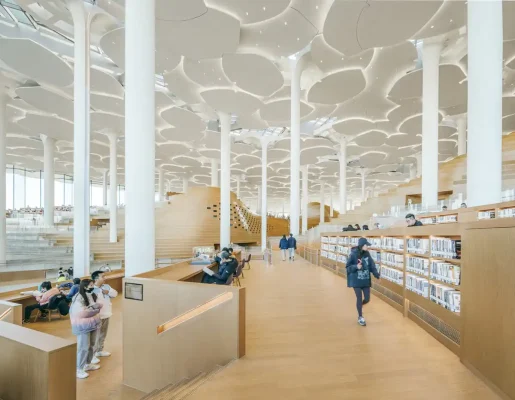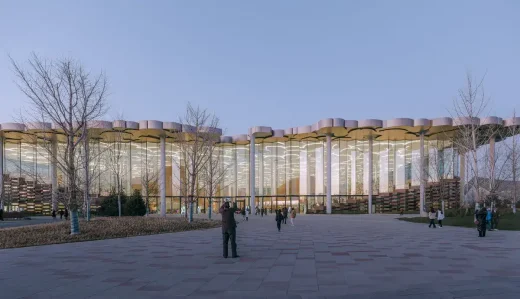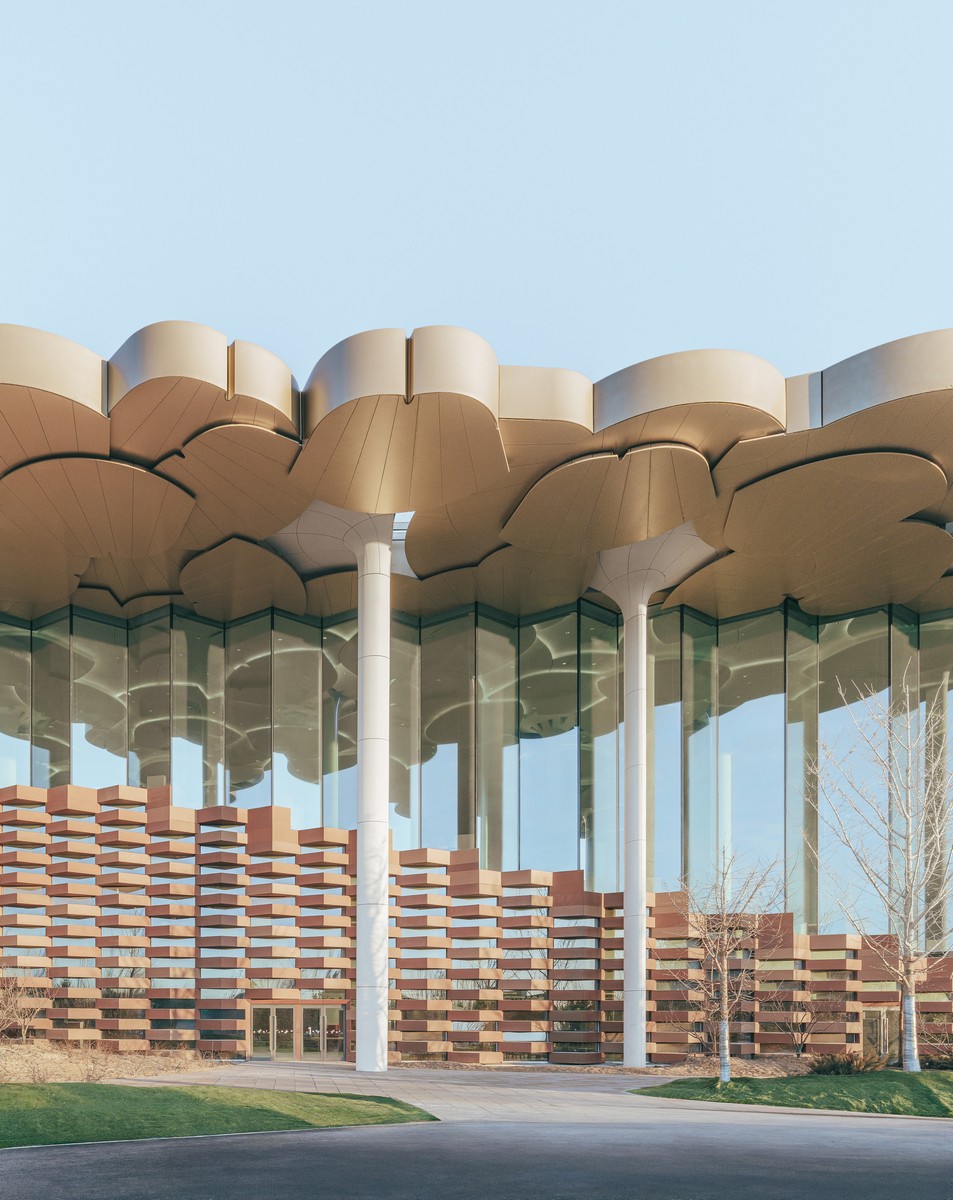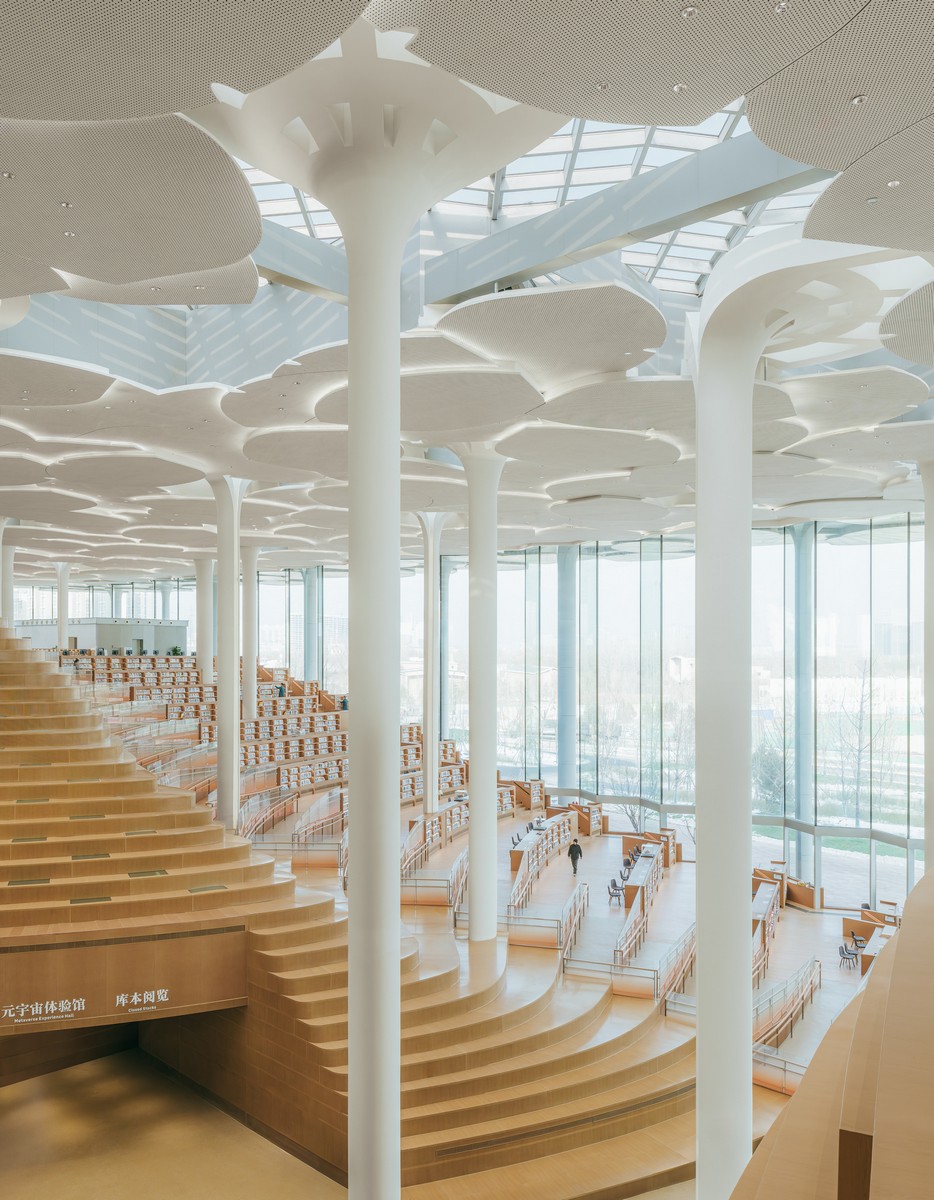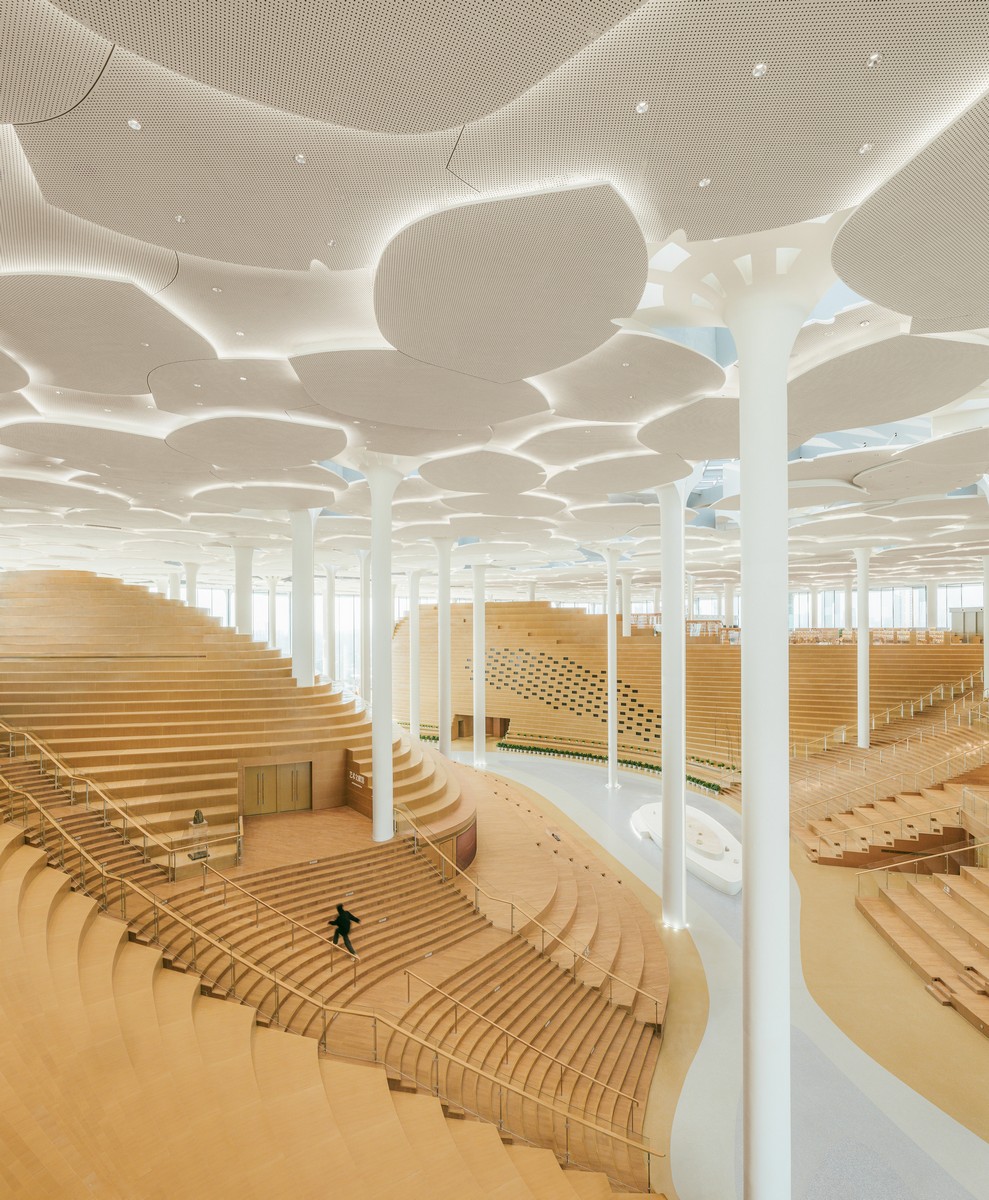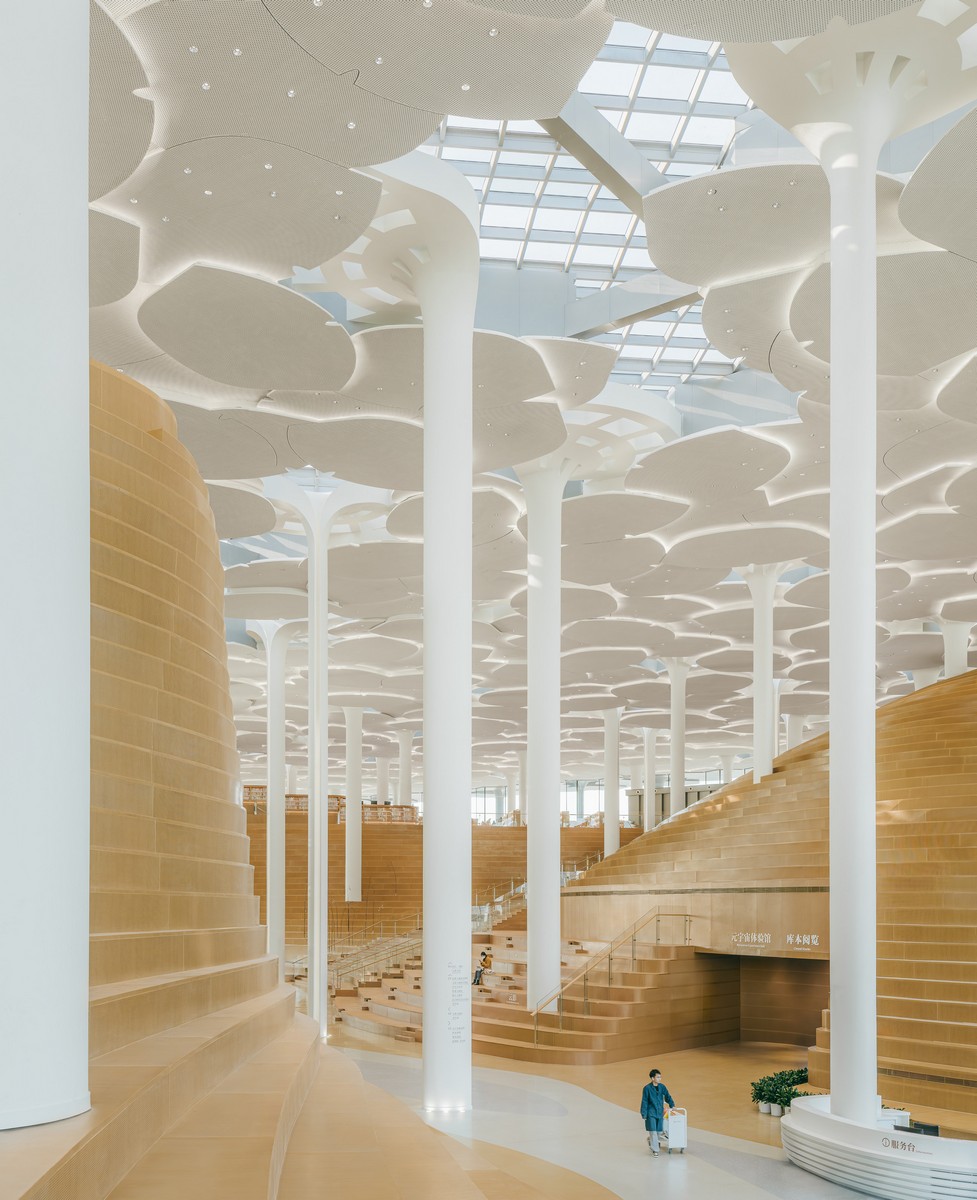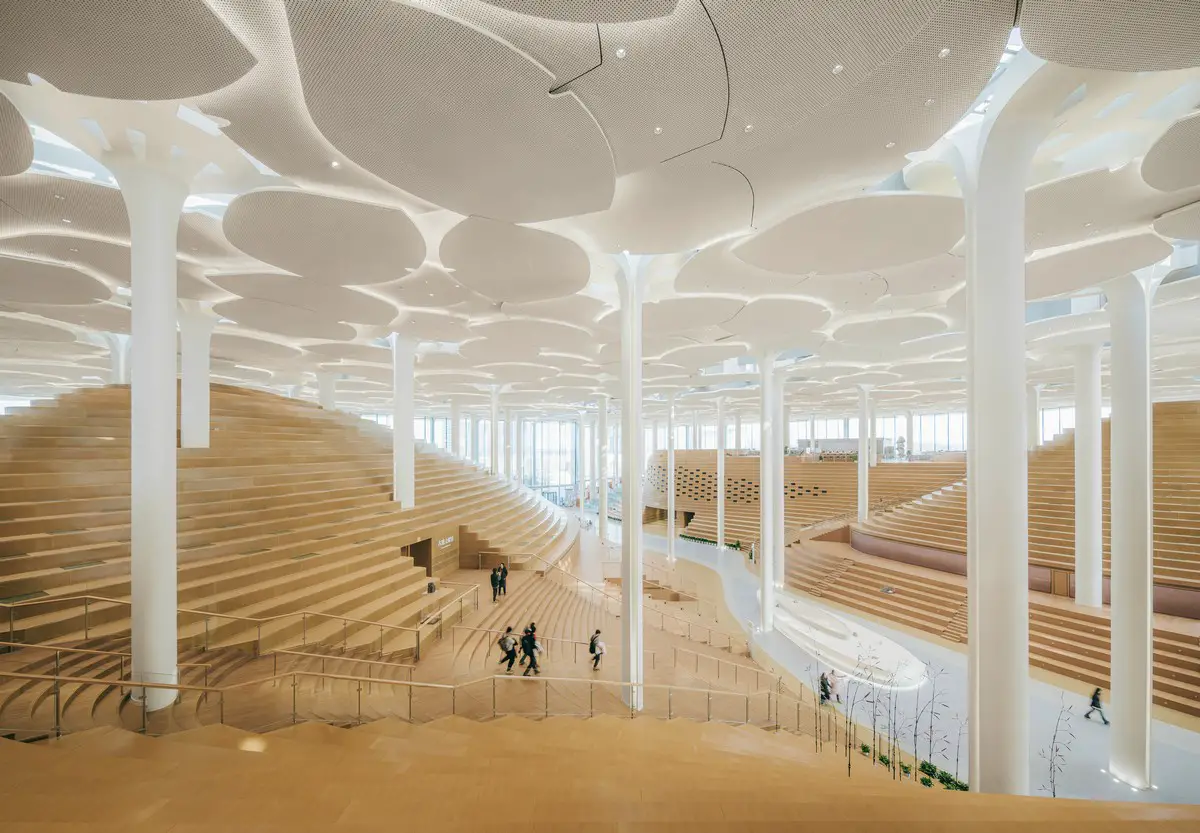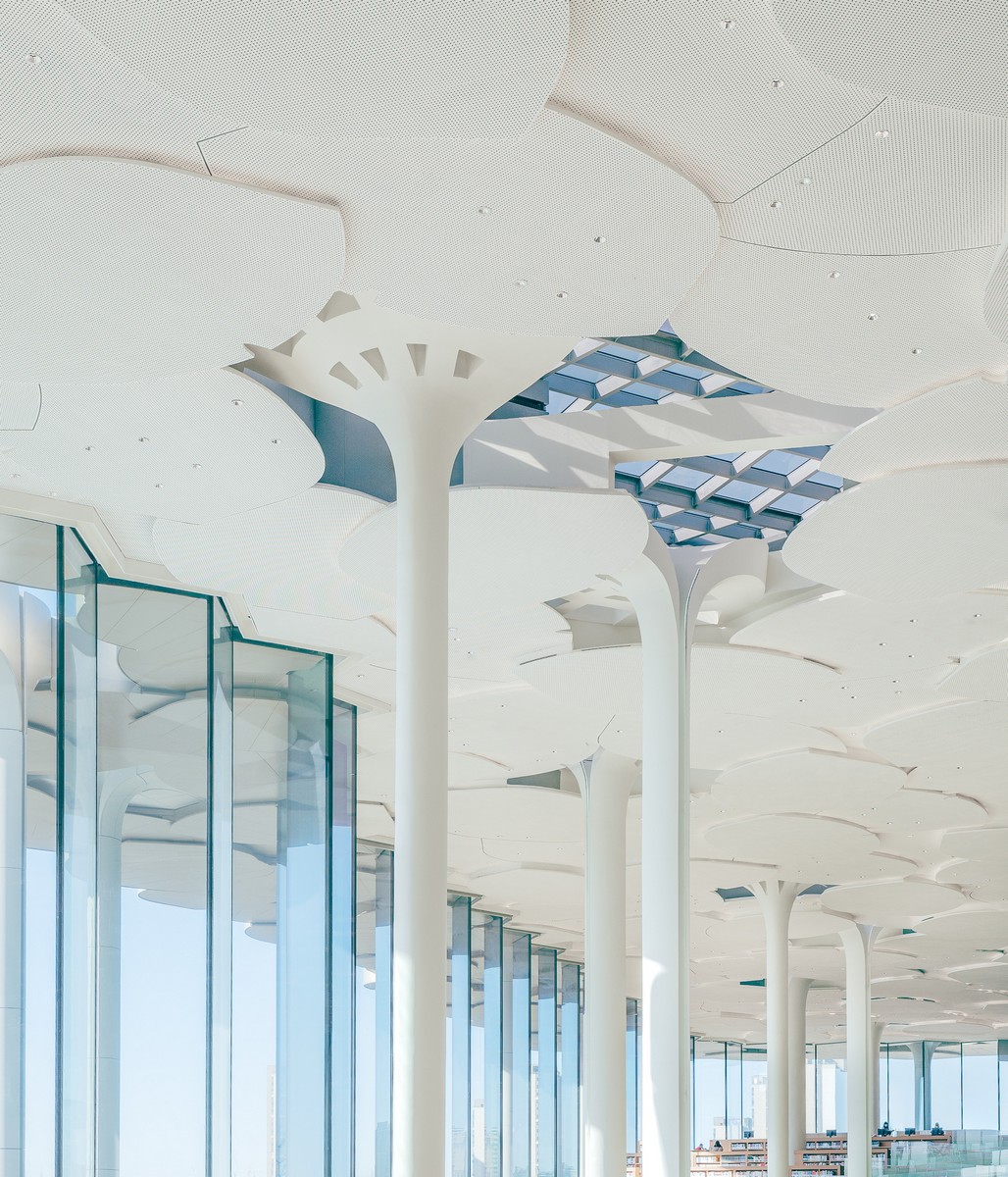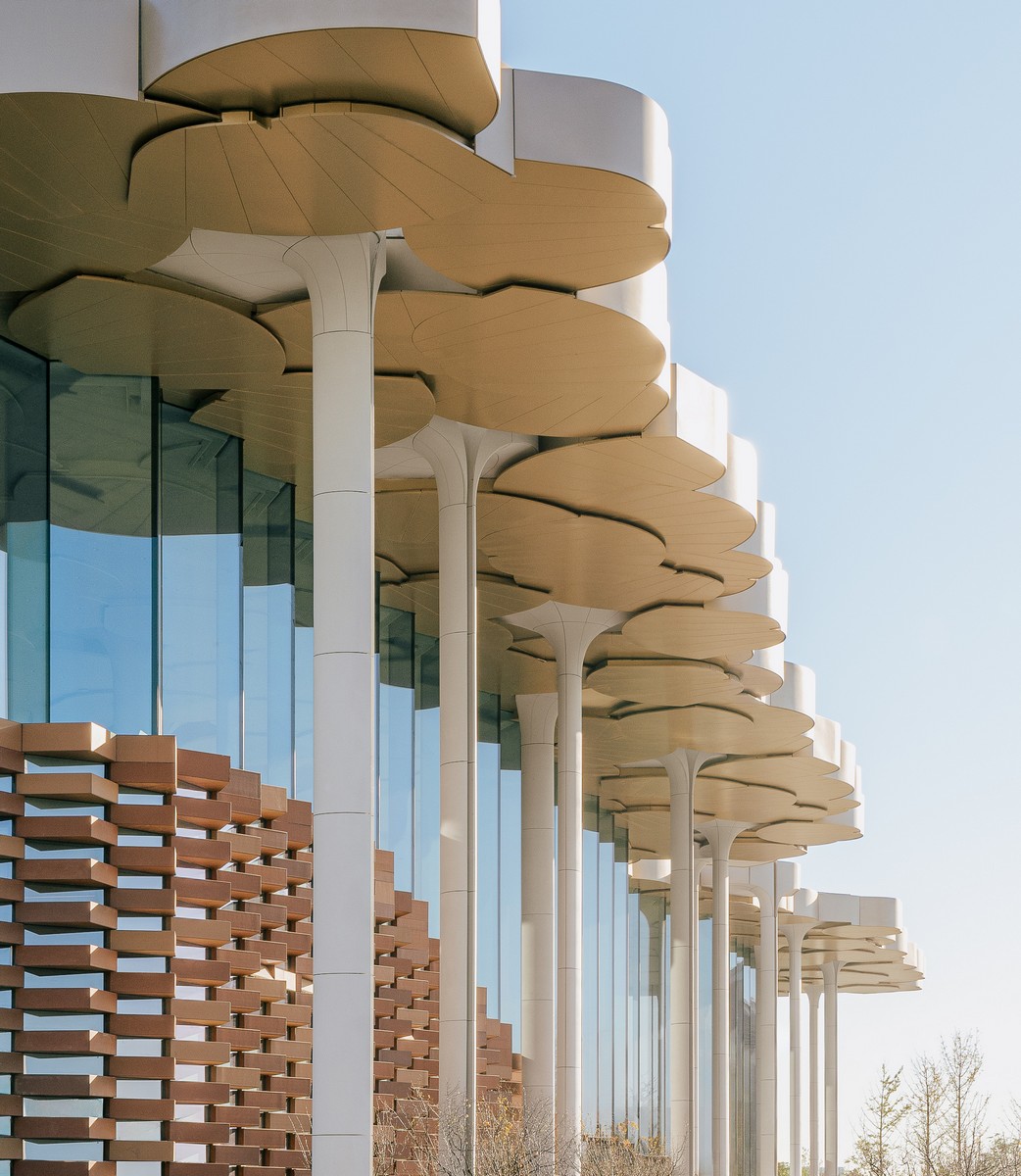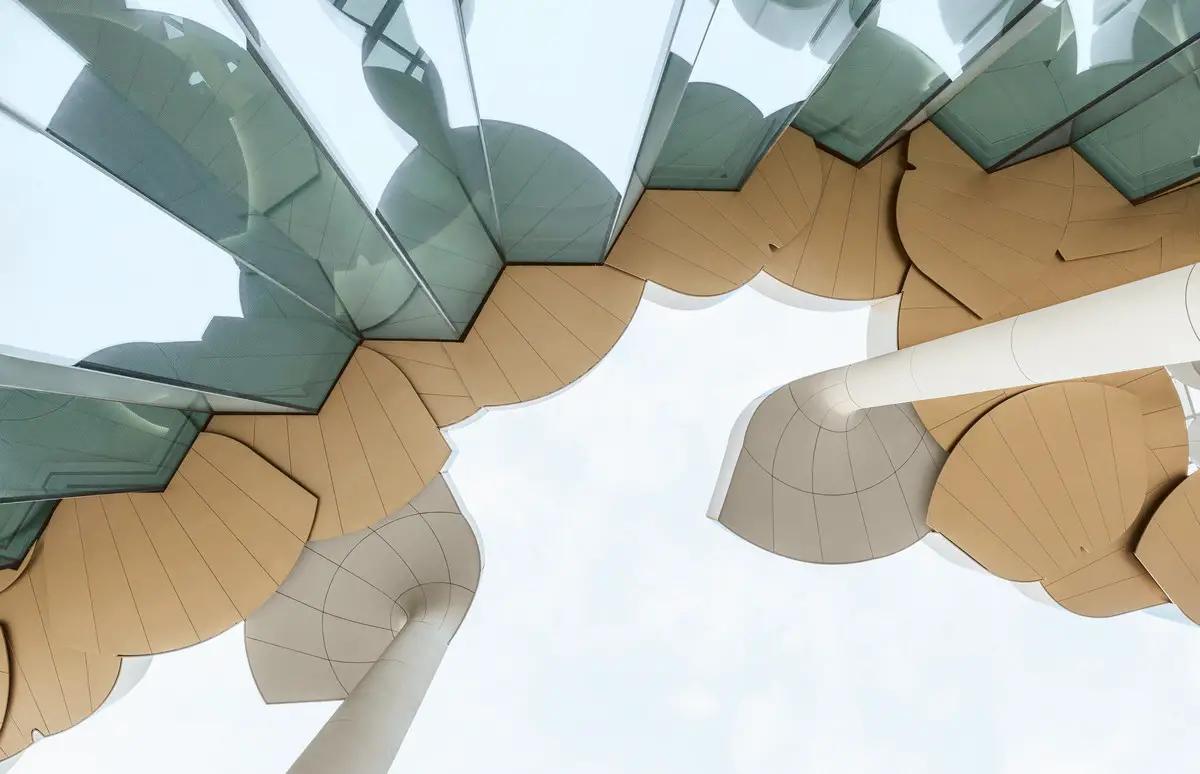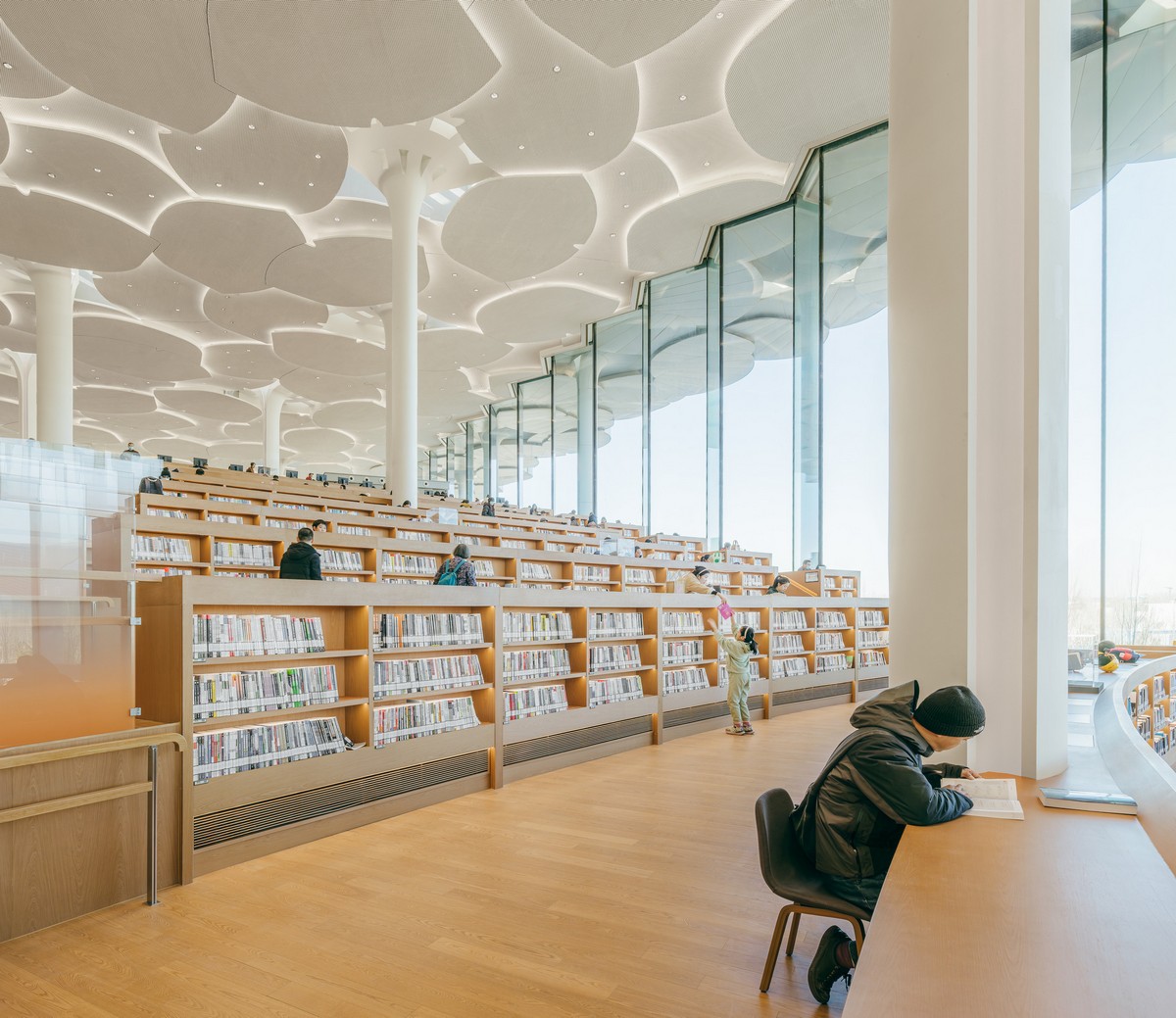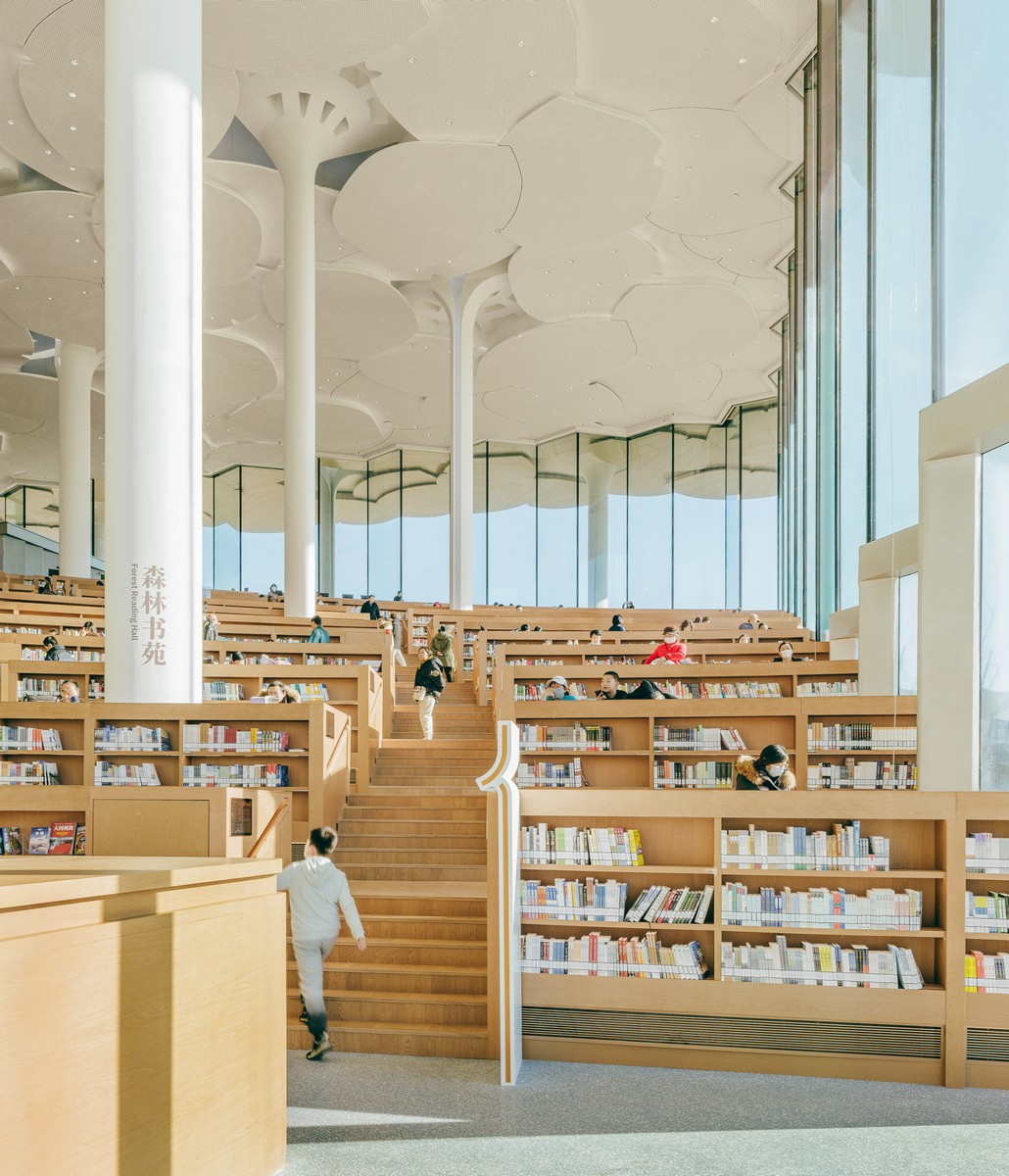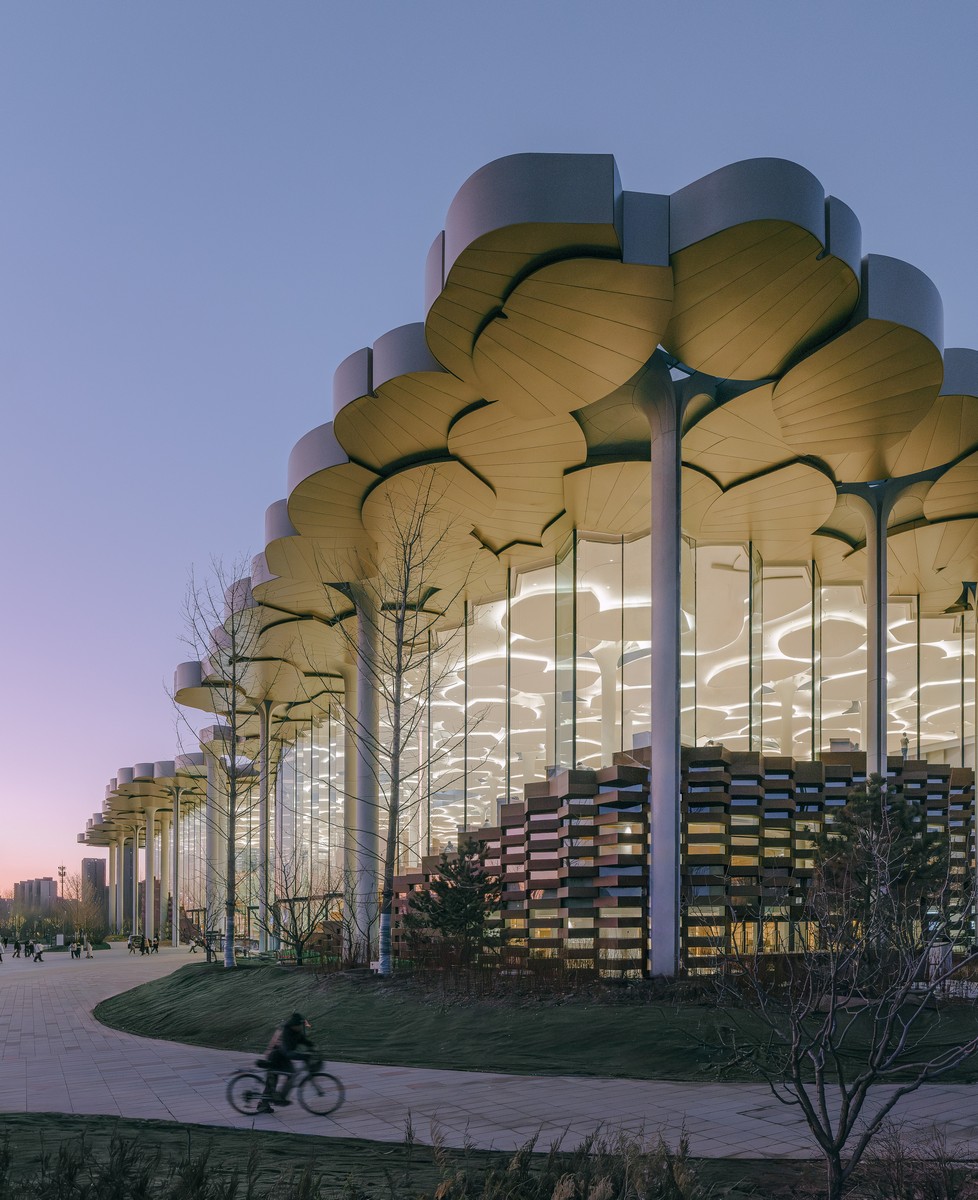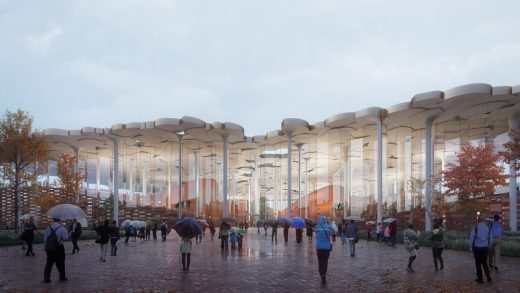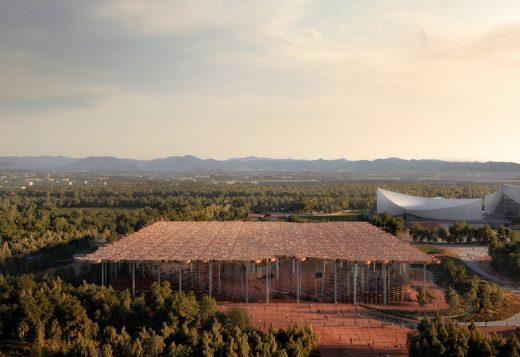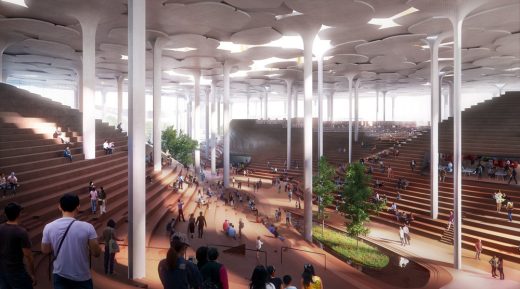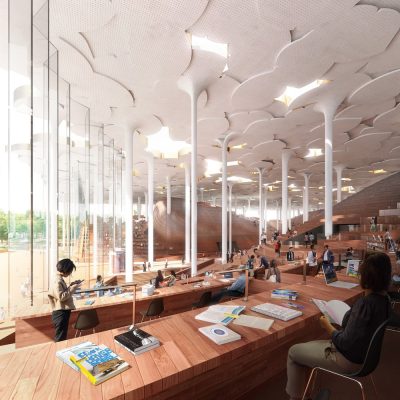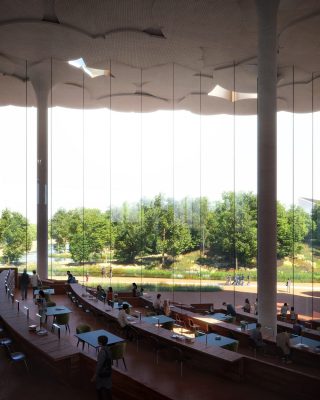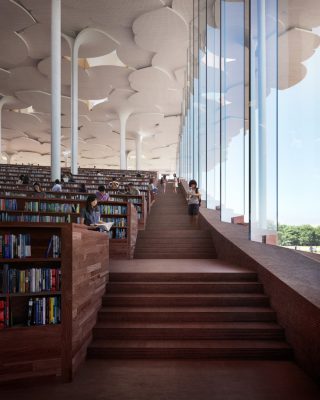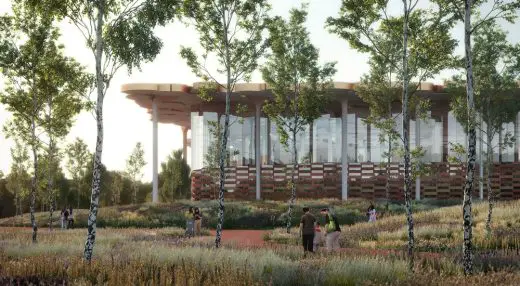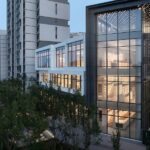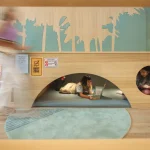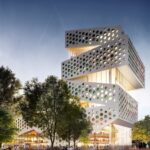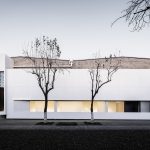Sub-Centre Library China, Beijing smart building, Chinese architecture design, Norwegian architect
Beijing Sub-Centre Library in China
Updated 3 November 2024 + 26 Feb 2024
Design: Snøhetta, Oslo
Location: Tongzhou District, Beijing, People’s Republic of China
Photos by Yumeng Zhu
Beijing City Library, Snøhetta, Beijing, China is on the shortlist for this year’s Dezeen Architecture Awards. Also included on the shortlist are buildings by Schemata Architects, URBANUS, Studio Gang, Stanton Williams and Grimshaw.
Beijing City Library Building
Snøhetta unveils the world’s largest climatized reading space with their new Beijing City Library.
Snøhetta’s Beijing City Library has opened doors for visitors as the world’s largest climatized reading space. It is the firm’s latest innovation in the library typology, thirty-five years after they began work on Bibliotheca Alexandrina in Egypt. The project introduces a contemporary yet indelible place for learning, knowledge-sharing, and socializing to Beijing’s rich cultural and intellectual scene.
The new library building is located in Tongzhou District, a designated sub-center of Beijing that is often considered the eastern gateway of the capital. As one of three new major cultural buildings in Tongzhou, the Beijing City Library further establishes the area as both a vibrant district in itself and an extension of Beijing‘s urban fabric. It anchors the neighborhood’s ambitious masterplan and will help to catalyze its transformation from a relatively undeveloped area into a lively arts and cultural destination. New transit links to Beijing’s center are underway, promising to further integrate Tongzhou with the city and drive visitors to the sub-center.
Snøhetta was awarded the Beijing City Library in 2018 through an international competition and the project was completed with local partner ECADI. The firm is currently working on three libraries in the United States: Charlotte Mecklenburg Library, Far Rockaway Library, and Westchester Square Library.
Reinstating the Library’s Relevance in the Digital Age
A decade or so ago, libraries were thought to be a disappearing typology as digitization has increasingly made information accessible at any time and place. To reinstate the library’s relevance in the 21st century, Snøhetta set out to offer a new vision for how it looks, works, and serves the community. The Beijing City Library draws focus on the physicality of a book as an object and the conscious exercise of turning the pages to take in the written word as the primary experience amidst the picturesque setting of hills, trees, and the Tonghui river.
“It is the love people have for books that has made libraries survive the digital age and hold new potential to give back more to the city and its public”, notes Kjetil Trædal Thorsen, Co-Founder and Partner at Snøhetta. “It is up to us to reinterpret the relationship between body, mind, and the surroundings to rekindle the joy of reading away from the screen. Libraries are here to stay.”
To reestablish the library’s role as an important pillar of public and intellectual life, and become more than a mere repository of books, Snøhetta has positioned the building as a center for learning, culture, and community. Drawing on the historical origins of libraries finding innovative responses to the needs of their time and place, Beijing City Library makes the open exchange of ideas and human dialogue its core purpose. Throughout, there are dedicated spaces for exhibitions, performances, conferences, and the restoration of ancient books. The building firmly rejects the argument of the library becoming a derelict typology with the numerous possibilities it creates, by fostering an emotional connection between books, people, and the natural landscape beyond.
“The role libraries play in society and the way people use them has vastly changed,” says Robert Greenwood, Partner and Director of Asia Pacific at Snøhetta. “They are now needed to function as vibrant community spaces, enabling social interaction and knowledge-sharing.”
Sculpting the Valley and the Hills within the Library
The glass-lined building invites nature into the reading space and lends transparency to the enriched interior environment when viewed from outside. At the heart of the library is a sweeping, nearly 16-meter-tall welcoming forum off of which rise stepped terraces along smooth, rhythmic curves. Carved through the center is a meandering pathway called the Valley, which serves as the main circulation artery of the building. The Valley mirrors the course of the nearby Tonghui river, seamlessly continuing the experience of the landscape beyond and linking the north and south entrances to lead visitors to all other spaces inside.
The terraced hills rising from the Valley are designed to create a sculpted interior landform that serves as the ground, seating, and shelving—an informal zone with opportunities to relax, talk, or read quietly, all while staying connected to the larger space. Semi-private reading areas and conference rooms are embedded into the hills, while book stacks and table seating are set on long, flat areas atop. This central open area is fully accessible and incorporates one of the largest book Automated Storage and Retrieval Systems (ASRS) in the world.
Punctuating the large space to transition between the scale of the Valley and the books are tall, slender columns that mushroom into flat panels shaped like ginkgo leaves—referencing a 290-million-year-old tree species native to China. The overlapping panels and the interstitial glass inserts create a canopy-like roof that floods the interiors with filtered daylight. Under this ginkgo canopy, one can reach the summit that overlooks the valley of books and the horizon of the vast landscape beyond. This experience of oneness with the immediate surroundings and the imagined world offered in books allows the reader to forge memories that are unique to the place.
“The terraced landscape and tree-like columns invite visitors to lift their gaze and focus at a distance, taking in the bigger picture. This is a place where you can be sitting under a tree, reading your favorite book”, says Greenwood. “The Beijing City Library has an intergenerational quality about it, where you would pass on your stories to children and introduce them to the titles you’ve loved.”
At the northern and southern edges of the building where real ginkgo trees are planted at the entry points, the hills focus their views outwards to further enhance the connection with nature. The library celebrates Beijing’s natural and cultural heritage by integrating reading, performance, and landscape together.
Setting the Green Standard for Libraries with Sustainable Technology
The Beijing City Library rethinks how libraries today can address the pressing climate challenges while incorporating cutting-edge technology to improve visitor experience. The building achieved China’s GBEL Three Star, the highest attainable sustainability standard in the country, by minimizing both embodied and operational carbon. The project is as much a steward of its environment as of the communities it serves.
The use of modular components and a rationalized structural grid reduces the manufacturing waste for the building. For the ginkgo tree columns, a single module type is rotated on a 9x9m grid throughout the building to give the appearance of variety while being efficient to fabricate and install. These columns also house integrated technology to control interior climate, lighting, and acoustics, as well as collect rainwater from the roof to be reused for irrigation by channeling it to a green infrastructure system.
Generous roof overhangs reduce solar gain on the glass facades—currently the largest load-bearing glass system in China—achieving an important design element without compromising on sustainability. To further optimize the facade, the design reduces the height of the glass on the east and west wells and uses insulated low-E glass. The roof has integrated photovoltaic (BIPV) construction elements that replace the conventional roofing and facade materials, utilizing the prime exposure of the rooftop to sunlight for renewable energy production.
Sub-Centre Library in Beijing, China – Building Information
Architect: Snøhetta
Project Name: Beijing City Library
Timeline: 2018-2023
Client: Beijing Planning and Natural Resource Bureau
Location: Beijing City Library, Lv Xin Road Courtyard No.1; Building No.3; Tongzhou District, Beijing
GFA: 75,000 sqm
Height: 22.3m
Status: Completed
Disciplines (by Snøhetta): Architecture, Interior Architecture
Typology: Library
Certification: Green Building Evaluation Label (GBEL)—“China Three Star”
Collaborators:
Executive architect: ECADI
Structural, geotechnical, and civil engineer: ECADI
Cost Consultant: ECADI
Building sustainability engineer: ECADI
Façade & BMU engineer: Eckersley O’Callaghan, Meinhardt
Lighting designer: ECADI
Main Contractor: China Railway Construction Engineering Group
Photography: Yumeng Zhu
Images by Plomp
The new Beijing Sub-Centre Library due to complete by the end of 2022, will offer a contemporary yet timeless space for learning, knowledge sharing and open discussions, as well as celebrating the cultural richness of Beijing and China at large.
Beijing Sub-Centre Library
Aiming to set new standards for sustainable library design, the Beijing Sub-Centre Library will become distinctly different to conventional libraries, utilizing technology, smart design and local resources.
Following an international design competition win in 2018, Snøhetta was commissioned to design the new sub-centre library in the Chinese capital and has developed the architectural, landscape, and interior design in partnership with local partner ECADI. Construction started in 2020 and since then, the roof has been put in place and the tall glass enclosure, up to 16 meters, is currently under installation. At completion, this will be China’s first self-supporting glass facade project.
Openness and inclusion
The library was designed and created to celebrate a public space for learning, information exchange and open discussions, as well as celebrating Beijing’s heritage and rich cultural history of science, art and performance. This has been emphasized by creating a common space as the centre of the library, highlighted by a prominent sculpted learning landscape that covers and permeates throughout the whole library.
The big open space of the library is designed to bring people together – spatially but also intellectually: the large reading landscape promotes distribution and access to knowledge and creates an experience that is distinctly different to conventional sections of libraries. This openness gives people of all ages the opportunity to meet on one surface and interact in an amphitheatre-like space. Similar open spaces designed to promote interaction and exchange of knowledge can be found at different locations throughout the whole building.
Because of the highly transparent building façade, the library reveals itself and its inner activities to passers-by, inviting them into this generous space. On the inside of the building, the central valley forms the backbone of the library. Besides serving as the main circulation space from the north side of the building to the south side, it links people to all relevant spaces on top of and under the reading landscape.
A forest of knowledge
Extended from the sculpted reading landscape are columns that reach up to support the roof – a ginkgo forest-like canopy. Each tree column is also a building technology component, resulting in a distributed technology system that tackles climate control, lighting, acoustic comfort, and rainwater disposal. The stepped landscape areas with the tree-like surroundings invite people to sit down and take a break at any time on their journey through the building – creating an informal zone and the notion of sitting under a tree reading your favourite book.
Under the roof canopy and atop the sculpted landscape is a variety of experiential spaces where visitors can find their private place for reading and learning while always being connected to the larger common area. Creating a feeling of being tall and low, open and closed, private and public all at the same time. There are no designated “sections” or categorizations of knowledge.
A library for the future
Beijing sub-centre library aims to set a new benchmark for future library design in many aspects – from building and enclosure technology, social and environmental sustainability, to public ownership in cultural spaces. When creating the new Beijing sub-centre Library, Snøhetta and its partners have strived to meet the highest standards possible when it comes to sustainability.
The roof has integrated photovoltaic (BIPV) construction elements that replace the conventional roofing and facade materials, utilizing the prime exposure of the rooftop to sunlight for renewable energy production and creating one of the most environmentally friendly roofs possible.
The roof also has an overhang to reduce solar gain. The glass height has been reduced on the walls facing east and west, as well as adding an active sun-shading device facing the south and west façade. The glass itself is an insulated glass unit with Low-E- performance. All the major materials for the construction have been sourced locally, and the use of modular components with a rationalized structural grid has been used to reduce the need for customization for both the columns and the roof.
The new Beijing sub-centre library is due to be completed by end of 2022.
Sub-Centre Library Beijing, PRC – Building Information
Categories: Architecture, Interior, Landscape, Library
Timeline: 2018 – 2022
Status: Under construction
Location: Beijing, China
Client: Beijing planning and natural resource bureau
Images: Plomp
Sub-Centre Library, Beijing China images / information received 170122 from Snøhetta Architects, Oslo
Location: Beijing, China, eastern Asia
Beijing Architecture
Beijing Architecture Walking Tours
WAA Riverside Gastropub Space Design, Chaoyang
Architects: Fon Studio
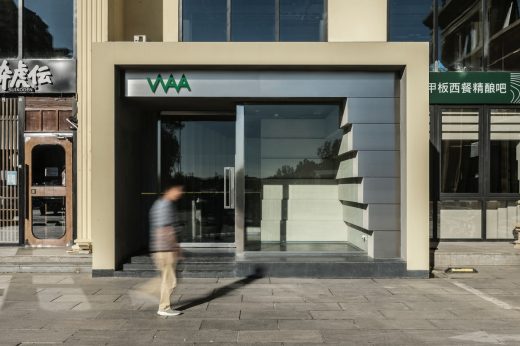
photograph : Fon Studio
WAA Riverside Gastropub, Chaoyang
InterContinental Sanlitun
Architects: CCD/ Cheng Chung Design
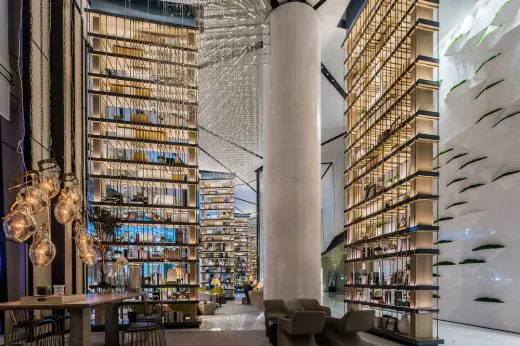
image from architects
751 Fashion Buyer Shop
Design: Zhang Hai’ao (HDD) – Shanghai Huadu Architecture&Urban planning co.ltd
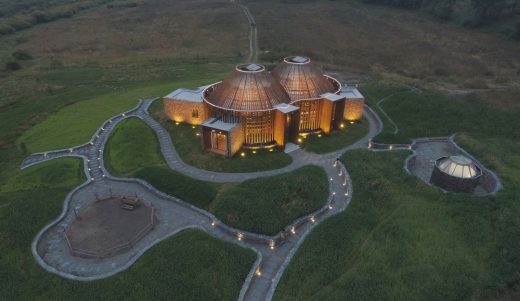
photo : Su Shengliang
Contemporary Library Building Design – article by Adrian Welch
Northern Chinese Architecture
DianDianYiPin tea restaurant
Architects: Golucci International Design
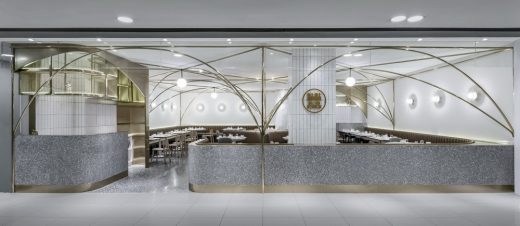
photograph : Lulu Xi
Mini Hill – Lily Nails Salon
Architects: ARCHSTUDIO

photo © Jin Weiqi
Architecture Walking Tours – city walks
Comments / photos for the Sub-Centre Library, Beijing China designed by Snøhetta Architects, Oslo, Norway, page welcome.

